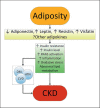Obesity and Kidney Disease: Hidden Consequences of the Epidemic
- PMID: 28785562
- PMCID: PMC5527180
- DOI: 10.1159/000452965
Obesity and Kidney Disease: Hidden Consequences of the Epidemic
Abstract
Obesity has become a worldwide epidemic, and its prevalence has been projected to grow by 40% in the next decade. This increasing prevalence has implications for the risk of diabetes, cardiovascular disease, and also for chronic kidney disease. A high body mass index is one of the strongest risk factors for new-onset chronic kidney disease. In individuals affected by obesity, a compensatory hyperfiltration occurs to meet the heightened metabolic demands of the increased body weight. The increase in intraglomerular pressure can damage the kidneys and raise the risk of developing chronic kidney disease in the long-term. The incidence of obesity-related glomerulopathy has increased 10-fold in recent years. Obesity has also been shown to be a risk factor for nephrolithiasis, and for a number of malignancies including kidney cancer. This year, the World Kidney Day promotes education on the harmful consequences of obesity and its association with kidney disease, advocating healthy lifestyle and health policy measures that make preventive behaviors an affordable option.
Keywords: Chronic kidney disease; Kidney cancer; Nephrolithiasis; Obesity; Prevention.
Figures


Similar articles
-
Obesity and Kidney Disease: Hidden Consequences of the Epidemic.Can J Kidney Health Dis. 2017 Mar 8;4:2054358117698669. doi: 10.1177/2054358117698669. eCollection 2017. Can J Kidney Health Dis. 2017. PMID: 28540059 Free PMC article.
-
Obesity and kidney disease: hidden consequences of the epidemic.Clin Kidney J. 2017 Feb;10(1):1-8. doi: 10.1093/ckj/sfw139. Epub 2017 Jan 25. Clin Kidney J. 2017. PMID: 28638599 Free PMC article.
-
Obesity and kidney disease: hidden consequences of the epidemic.Future Sci OA. 2017 Feb 6;3(3):FSO159. doi: 10.4155/fsoa-2016-0081. eCollection 2017 Aug. Future Sci OA. 2017. PMID: 28883987 Free PMC article. Review.
-
Obesity and kidney disease: hidden consequences of the epidemic.J Nephrol. 2017 Feb;30(1):1-10. doi: 10.1007/s40620-017-0377-y. J Nephrol. 2017. PMID: 28214961 Review.
-
Obesity and Kidney Disease: Hidden Consequences of the Epidemic.Nephron. 2017;135(4):243-251. doi: 10.1159/000455698. Epub 2017 Feb 8. Nephron. 2017. PMID: 28171864
Cited by
-
Rodent models of AKI and AKI-CKD transition: an update in 2024.Am J Physiol Renal Physiol. 2024 Apr 1;326(4):F563-F583. doi: 10.1152/ajprenal.00402.2023. Epub 2024 Feb 1. Am J Physiol Renal Physiol. 2024. PMID: 38299215 Free PMC article. Review.
-
Obesity in the critically ill: a narrative review.Intensive Care Med. 2019 Jun;45(6):757-769. doi: 10.1007/s00134-019-05594-1. Epub 2019 Mar 19. Intensive Care Med. 2019. PMID: 30888440 Review.
-
COVID-19 in Chronic Kidney Disease: The Impact of Old and Novel Cardiovascular Risk Factors.Blood Purif. 2021;50(6):740-749. doi: 10.1159/000514467. Epub 2021 Mar 22. Blood Purif. 2021. PMID: 33752209 Free PMC article. Review.
-
Glomerular Hyperfiltration as Predictor of Cardiometabolic Risk Factors among Children and Adolescents: The Childhood and Adolescence Surveillance and Prevention of Adult-V Study.Int J Prev Med. 2018 Mar 19;9:33. doi: 10.4103/ijpvm.IJPVM_38_18. eCollection 2018. Int J Prev Med. 2018. PMID: 29619157 Free PMC article.
References
-
- Forouzanfar MH, Alexander L, Anderson HR, Bachman VF, et al. Global, regional, and national comparative risk assessment of 79 behavioural, environmental and occupational, and metabolic risks or clusters of risks in 188 countries, 1990-2013: a systematic analysis for the Global Burden of Disease Study 2013. Lancet. 2015;386:2287–2323. - PMC - PubMed
-
- Cattaneo A, Monasta L, Stamatakis E, Lioret S, Castetbon K, Frenken F, Manios Y, Moschonis G, Savva S, Zaborskis A, Rito AI, Nanu M, Vignerova J, Caroli M, Ludvigsson J, Koch FS, Serra-Majem L, Szponar L, van LF, Brug J. Overweight and obesity in infants and pre-school children in the European Union: a review of existing data. Obes Rev. 2010;11:389–398. - PubMed
-
- Olaya B, Moneta MV, Pez O, Bitfoi A, Carta MG, Eke C, Goelitz D, Keyes KM, Kuijpers R, Lesinskiene S, Mihova Z, Otten R, Fermanian C, Haro JM, Kovess V. Country-level and individual correlates of overweight and obesity among primary school children: a cross-sectional study in seven European countries. BMC Public Health. 2015;15:475. - PMC - PubMed
Publication types
LinkOut - more resources
Full Text Sources
Other Literature Sources

